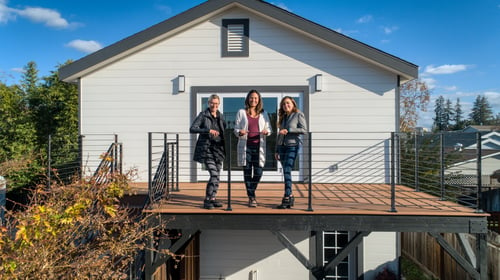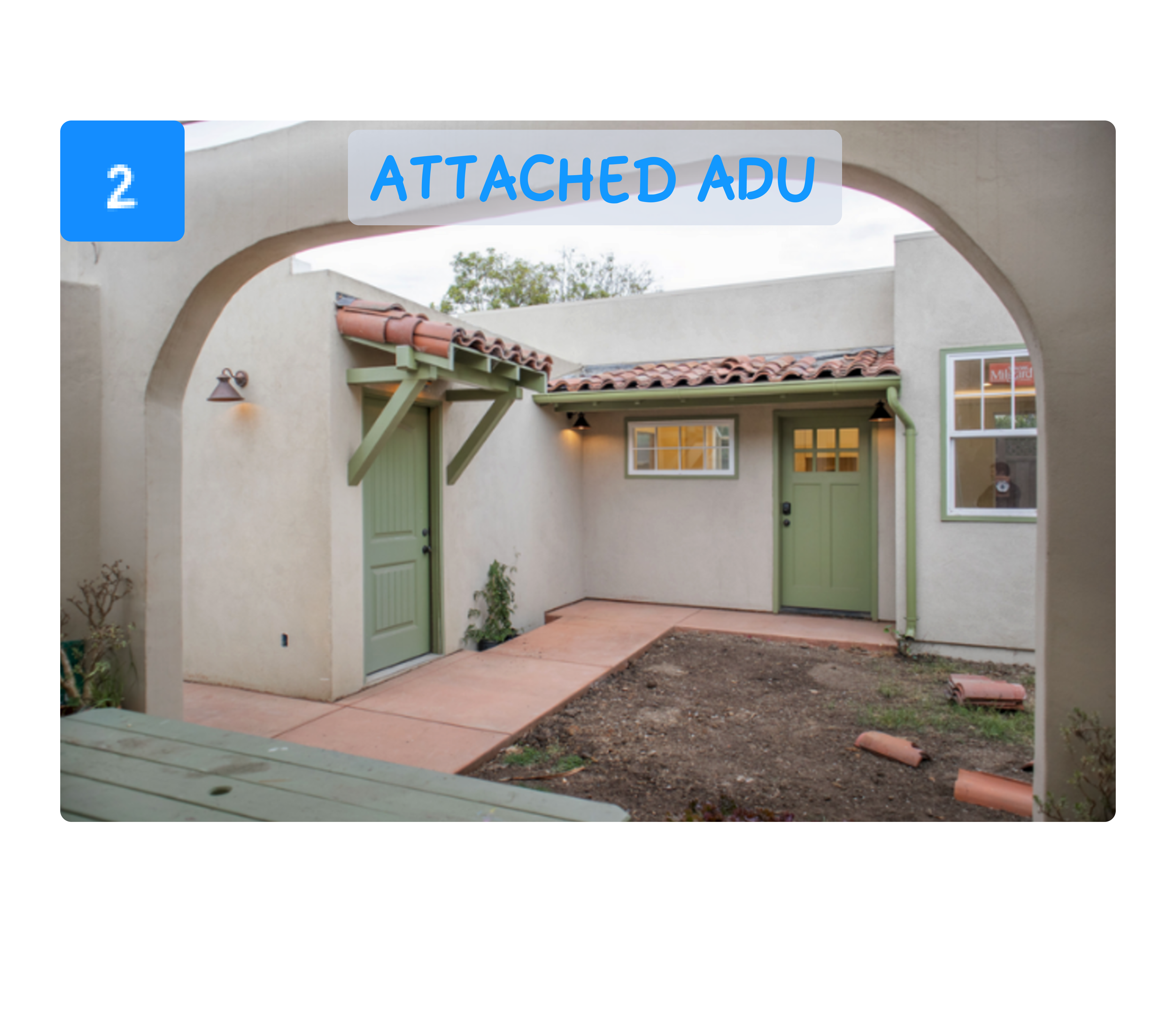ADU Design - Choosing a Garage Conversion or Over the Garage ADU
Converting your garage can increase your properties resale value and potentially provide income through rental. As with all major construction projects, there are many factors to consider when converting your existing garage into an ADU or adding an ADU above your garage including setbacks, access, structural integrity of the existing structure, and cost.
Whether you need a guest bedroom for friends and family or a place for your parents or grandparents, a garage conversion is one of the easiest ways to add additional living space to your property. By adding a kitchen, a bedroom, and living space to your garage you can add the square footage without building a new structure, or moving. Garage conversions are less expensive than adding a standalone unit, since they use existing infrastructure. With lower capital requirements, project financing is also easier. Over garage ADUs are more costly but may be the best option when space is limited and budget isn’t a major concern.
The easiest way to know what standards your garage was built to is to either check the permitting office for construction records or by knowing the age of the structure. Older structures are less likely to pass inspection without modifications. Original permit information is especially important for detached garages located on or near adjacent property lines. In many cases detached garages in older neighborhoods were built without permits and on property lines which will complicate your project.
Regulations
Height
While all single story garage conversion projects are allowed by right, as are ADUs of up to 16 feet, some municipalities place additional restrictions on over-garage ADUs such as height or floor area limitations. Some cities may require discretionary permit review and public comment.
Parking
Unlike ADUs converted from primary living space or garage conversion, adding an ADU over your garage will require parking. If the garage space below is large enough to share between the two units then you will not likely need replacement parking but keep this in mind when designing your project.
Setbacks
Many municipal standards require second story additions to have greater setbacks from property lines than the first story. In some cases this is driven by design, to match the character of the existing neighborhood and primary home, in other cases it’s a fire safety or privacy requirement.
Size
In most cases, single story conversions of existing space allows for ADUs as large as the original accessory structure, as well as 150 square foot expansion to allow for ingress and egress.
Structural
When working with an existing structure either for a conversion or an addition, you will want to evaluate the structural integrity of the framing, the foundation, and the room. A qualified builder or engineer can take a look at the space you’re considering working with and tell you if there is any retrofitting that needs to take place first. Here are some things to keep in mind.
Foundation
Footing Size and Depth
Check the existing footing size and depth by carefully digging along the side of the structure to find the bottom. Measure the depth and width of the footing to make sure it is at least 12 inches below grade with 12 inches of bearing width. The bottom plate of the framing must be 6 inches above grade, which can be accomplished through a raised footing or a curb wall.
Slab Depth and Condition
If your slab is visibly cracking, it likely won’t meet current building codes without modification. At a minimum, the slab should be 3.5 inches thick without rebar and 2" thick with rebar.
Vapor Barrier
A vapor barrier is required to meet residential building codes for any habitable space. This means that you need to cover any concrete slap that will be used as flooring. Usually this is accomplished with a 6mm plastic applied beneath the foundation, but because garages are not designed to be used as habitable space, most do not have any existing vapor barrier. In most of our projects, if the slab is intact, we are typically meeting the vapor barrier requirement with an applied vapor barrier product that is used as a coating over the slab as this meets the same specifications for air transfer as 6mm plastic.
Floor Slope
Most garage slabs were built to shed water at a 2% slope, which is not compliant with residential codes. You should determine if a slope in your garage exists and plan to level, fill, or float the floor before any work commences on the project.
Sightlines
Because ADUs are often used to rent, you’ll want to consider sightlines from windows and doors. Consider when each room is likely to be used and design the space to minimize overlapping uses. For example, make sure that main windows don’t face another home’s private space, and if they must, consider the height, shape, and opacity of the window. Consider privacy windows for rooms adjacent to high traffic areas where you want natural light.
Access
Garage conversions often require the removal of the main garage door but this doesn’t necessarily mean that you need, or in some cases can, replace this with a traditional home door. In some cases it will make more sense to have access located on the side or rear of the home for privacy.
In cases where you are building an ADU over a garage, keep in mind how the garage below will be used. If the garage is meant for use in the ADU, it might be possible to keep all upstairs access confined to an interior stairway. Exterior stairways may be optimal, or, in some cases, required, in which case you’ll need to look at setbacks requirements.
If you’re building an over garage ADU for an aging, elderly, or a disabled person you might consider a chairlift for the stairway or an elevator, both of which may be less costly and less space consuming than a ramp which, while possible for two story structures, are very large.
Cost
The main question most homeowners ask is how much a project will likely cost. Single story garage conversion projects are some of the most cost effective and fastest projects to complete. However some garage’s are too old to effectively convert and it would be more cost effective to demolish and build new in the existing footprint.
Conversely, over garage ADU construction can be one of the most costly ways to build an ADU. This is in large part because many garage’s need significant structural work to make the garage sturdy enough to hold the ADU, but also because the removal of the roof and the addition of the second story alone can often exceed the per square foot cost of new construction. Recent contractor estimates for a Los Angeles ADU that we designed over one customer’s garage ranged from $400 to over $700 per square foot which is nearly double the estimates for a stand alone new ADU or a simple, single story conversion project.
Example ADU garage conversion budget for a single story, 400 square foot, 2 car garage
- Architectural and Engineering plans: $2,000-$8,000
- Permits: $2,400-$15,000 (depending on location)
- Materials and Labor: $40,000-$150,000 (depending on the condition of the existing structure, the cost of materials, and the time spent on the project)
Whether you decide to convert your existing garage space or add an ADU over your garage, Housable can help you plan, design, and permit your ADU project. Read more about some of our ADU Design projects here.



